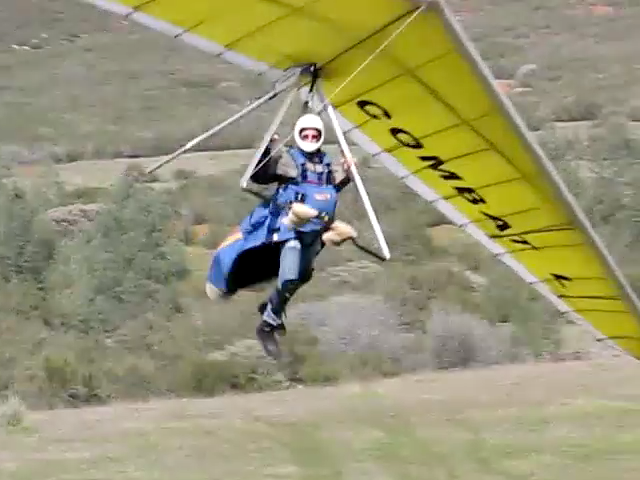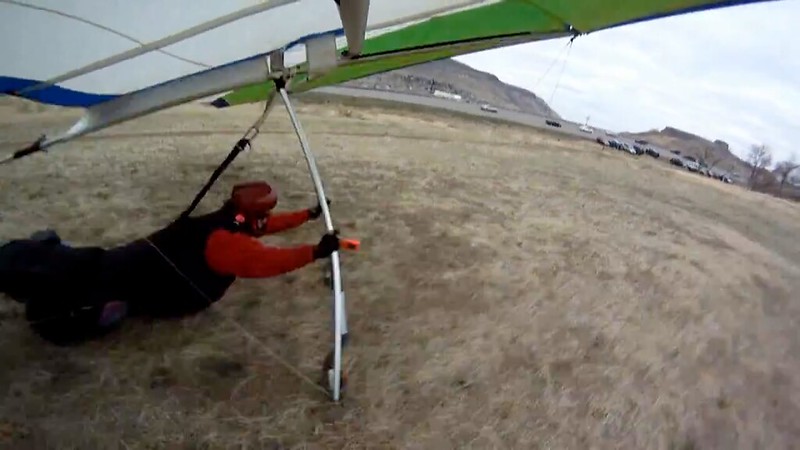The pilot has already passed the preferred landing point.
Bad Move #1. Deliberately, right?
The hill rises a bit and then drops off. There is an electric utility line and poles, brush, trees and more hillocks behind the hill. Very ugly places to impact.
Make that: Really Bad Move.
If he had stayed prone, he probably would have gone over the back.
1. Then, obviously, crashing into the trees, snapping two leading edge spars, and falling on his face was the right call. (I wonder if there are available videos of other people landing that day.)
2. NOW I understand that saying about the uselessness of runway behind you!
3. I'm of the opinion that one should have a real good reason for coming into a field in which the drag afforded by being upright versus prone is likely to be a critical factor in preventing one from overshooting the end or crest.
Yes, you are still flying but you need to consider the end of the lz.
1. Where I learned to fly - on the Jockey's Ridge dunes - overshooting the LZ was very seldom much of a problem.
2. However, I've always had a major phobia concerning the ends of LZs so I've always considered them well before reaching the beginnings of LZs.
3. And whenever the LZ is the least bit questionable I always arrive at its beginning as low as sanely possible but with very crisp maneuvering speed.
4. I'll betchya twenty bucks I could've landed Andy's Combat in those conditions in the space between the windsock and the shrubs which appear in the bottom left corner of the frame at 0:28 with no wheels and my hands duct taped to the basetube with no more damage than some grass stains on my parachute container and no observers saying "Oh shit!", "Oh fuck!", "He's alright.", "He's OK!", and/or "You're alright dude, you're PERFECT!" at any point during and/or after the procedure.
The only good aspect of that would be no video of the impact.
How is that EVER a good thing?
However, he took off without attaching himself.
In a video, he was seen to hold on to the glider for about fifty meters before hitting power lines.
Especially if it's somebody like Rooney or Davis. (I'd kill for a copy of that one.)
Didn't need to consider cross winds and side gusts did you?
Not on that particular occasion.
You always land straight into the wind.
1. I don't recall saying that.
2. No.
3. How did you arrive at that erroneous conclusion?
4. Assuming an adequate length of reasonably safe runway, when is it a bad idea to enter ground effect with a good head of steam?
Much, much, mucho mas easier and safer to do with ailerons.
I'm sure it is. I don't think there's anything that ISN'T much easier and safer to do with ailerons - especially towing.
I think that one went by you.
I don't think it did. And I'm not standing behind any curtains - I leave that to folk like Pilgrim, peanut, and tipvortex.
Nope, in the air, close to stall, in certain kinds of turbulence, close to the hill.
Sounds like an especially good glider not to fly close to stall in certain kinds of turbulence close to the hill.
Nope, the glider was a TRX and I never said "because you might overstress them and thus INCREASE your chances of a sidewire failure?" Those are your ideas and words.
I DO apologize.
http://www.kitestrings.org/post1258.html#p1258
Apparently you meant nothing of the sort.
The wire fails before the nico fails.
Yes. And in hang gliders that failure is virtually always AT the nico.
Corrosion and corrosion products can be seen. See corrosion, time to replace wires. See shiny wear marks, time to replace. Broken strands, same. I have a go no go guage to check any new cables that I have not made myself.
And then skip the load test 'cause:
- you've just checked your wires for corrosion, corrosion products, shiny wear marks, and broken strands
- the go / no go gauge readings were all good
- you just replaced your wires last month
- the wires you've been using for the past five years have long unblemished track records
- you might:
-- overstress the wires and thus INCREASE your chances of a sidewire failure
-- understress the wires and fail to detect a defective wire
-- break a defective wire
-- accidentally and unknowingly grind a wire into a sharp rock
-- step on a rattlesnake thinking it was a wire
- it's:
-- not a Wills Wing glider and the procedure isn't in the owner's manual
-- a really old Wills Wing glider and the procedure isn't in the owner's manual
-- a new Wills Wing glider but you haven't read the owner's manual
-- just CYA crap that the lawyers cooked up so Wills Wing could ship gliders with two millimeter wires
- wires very rarely fail in flight high enough to get hurt but too low for a parachute to open
- the trees will probably slow you down enough to keep you from getting killed
- the redundancy afforded by backup loops and hook knives is plenty good enough for hang gliding
- your:
-- dealer didn't do this when he went over the procedures
-- instructor told you to never do this
- Jim Gaar advises against it and he always uses a "cool" smiley at the end of his posts
- Davis never does them
- most people who don't do them have long track records
- someone might steal your harness while you're turned around stepping and pushing
- you're way more likely to get killed in a failure to hook in accident
- in hang gliding shit just happens and there's really nothing you can do about it anyway
Countless, until I learned to anticipate the spin and could counter it prone by reaching on the outside of the downtube and rapidly pulling it over.
So you're saying that prone was the preferable control configuration?
It was a combination move, pull over and pull up. It stopped the incipient spin and turned the glider the other way.
But eventually you learned to anticipate the spin and counter it prone by reaching the downtube and rapidly pulling it over.
Many times I let it spin to do a flat spin turn.
Exactly. You LET IT spin. A glider that's spinning is (hopefully) temporarily not under control. It may be doing what you want it to but it's making the calls and you're along for the ride until you decide to let or get the inside tip start flying again.
And if you've got plenty of air - fine - go nuts, do whatever you want, have fun. But here we're talking about landing approaches and touchdowns and maximizing control at all stages.
You were the one who brought up going up right at altitude.
Which - see above - you ceased doing as you improved your technique. Right?
I would dredge up the quote like Bob but my time is limited.
http://www.ushawks.org/forum/viewtopic.php?f=15&t=884
The Bob Show
Tad Eareckson - 2011/12/13 03:41:16 UTC
If you can't quote me I didn't say it.
Actually...
Bob Kuczewski - 2011/12/13 04:44:24 UTC
I'm not going to spend the time right now, but I will ask you to read everything you've written and post your own quote that comes closest to supporting my statement.
Bob's not all that good at providing quotes.
And...
Zack C - 2011/12/17 14:56:03 UTC
You continually misrepresent Tad's statements.
He tends to deliberately take them out of context and misrepresent them when he does.
Landings were easy. Fly a fast approach and flair hard.
I am starting to catch on now. I am not the sharpest tool in the shed. It takes me a while. You always land straight into the wind. No crosswinds! Got it!

Research "Dave Hopkins" if you are not conducting jihad against him.
The name's very familiar to me and the hairs on the back of my neck don't stand up when I hear it.
He piled a Mitchell wing into the rocks on the side of the hill at McClure at 60-70 mph. Walked away with trivial minor injuries.
Great!!! He should write up his procedure for piling a Mitchell Wing into the rocks on the side of the hill at McClure at sixty to seventy miles per hour so Bob can include it in his training manual.
Me... I'd rather hear how he got into a situation which terminated in his piling a Mitchell Wing into the rocks on the side of the hill at McClure at sixty to seventy miles per hour so I can include recommendations on how to avoid one in mine.
This is the last I have to say on this subject.
I'm always happy to get whatever I can.
Have fun

One does one's best.


